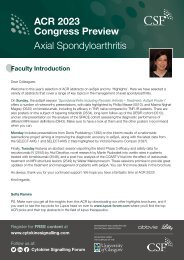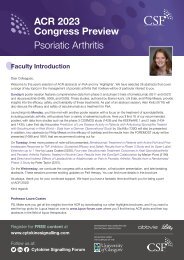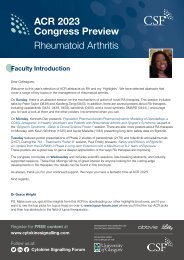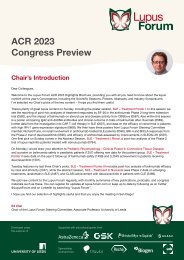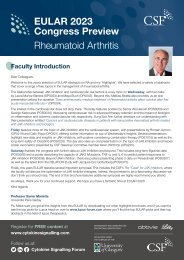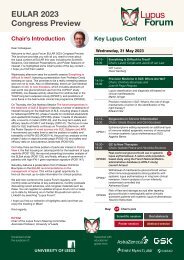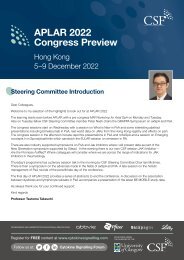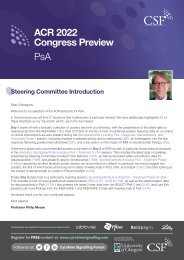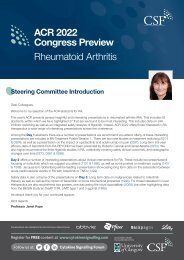EULAR 2018 Review
Create successful ePaper yourself
Turn your PDF publications into a flip-book with our unique Google optimized e-Paper software.
A case study of vasculitis in a patient with RA treated with tofacitinib<br />
Muraviev, et al. presented a case of polyarteritis nodosa (vasculitis) in a female patient<br />
with RA. The patient was hospitalised in December 2016 due to painful eruption of<br />
indurated nodules on her legs, ulceration of nodules on her legs, painful hip and ankle<br />
joints and morning stiffness; the patient had been receiving tofacitinib 10 mg/day since<br />
November 2015, with rapid achievement of minimum RA activity. Tofacitinib was<br />
discontinued in June 2016 due to increasing lab activity of vasculitis. Histopathology<br />
showed the presence of cutaneous and subcutaneous fat and destructive vasculitis, and<br />
acute, predominantly lobular panniculitis, suggestive of polyarteritis nodosa and other<br />
systemic vasculitis. A causal relationship between this adverse drug reaction and<br />
tofacitinib therapy was assessed as probable (Naranjo scale) [#0413].<br />
Musculoskeletal ultrasound for monitoring the effects of biologic therapy in RA<br />
Yu and colleagues reported that musculoskeletal ultrasound (MSUS) was a useful tool for<br />
monitoring and following-up the effects of biologic therapy in patients with RA, for the<br />
assessment of inflammatory and destructive changes. In a real-world study of 18 patients<br />
with RA who were treated with tofacitinib 5 mg BID for 12 weeks, there was a significant<br />
correlation between MSUS scores and conventional (clinical and laboratory) measures of<br />
disease activity [#0210].<br />
Tofacitinib in patients with PsA: pooled sub-analyses of OPAL Broaden and OPAL Beyond<br />
Kivitz, et al. investigated pooled data from OPAL Broaden and OPAL Beyond, looking at<br />
the efficacy of tofacitinib by background MTX dose in patients with PsA. In total, data from<br />
556 patients who received tofacitinib plus MTX or placebo plus MTX were included in this<br />
analysis. Most patients were treated with background MTX at doses ≤15 mg/week (66.7%;<br />
mean dose 12.6 mg/week) compared with >15 mg/week (33.3%; mean dose 19.8<br />
mg/week). At Month 3, tofacitinib 5 and 10 mg BID were generally associated with<br />
numerically greater ACR and HAQ-DI response rates and greater changes from baseline<br />
in HAQ-DI score compared with placebo. The magnitude of tofacitinib effects on efficacy<br />
outcomes appeared broadly similar between background MTX dose groups [#0902].<br />
In a second pooled sub-analysis of the OPAL Broaden and OPAL Beyond studies,<br />
Behrens and colleagues examined the impact of baseline demographics, disease activity<br />
and concomitant medication on ACR20 response rate and HAQ-DI. Compared with<br />
placebo, tofacitinib 5 and 10 mg BID consistently improved efficacy at Month 3 across all<br />
predefined subgroups evaluated (race, ethnicity, gender, geographic region, PsA duration,<br />
age, BMI, PsA subtype, distal inter-phalangeal joint involvement, arthritis mutilans status,<br />
spondylitis status, baseline CRP, PASDAS, PASI score, DSS=0, concomitant csDMARD,<br />
corticosteroid use), with the exception of current smoking status [#0921].<br />
A novel mechanism of action for tofacitinib<br />
Marzaioli, et al. reported preclinical results suggesting a novel mechanism of action for<br />
tofacitinib. Pre-treatment of monocyte-derived dendritic cells (Mo-DC) from patients with<br />
RA and PsA inhibited Mo-DC differentiation. Furthermore, the decreased ability of



